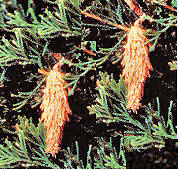|
 Bagworm
treatment, Halloween pumpkins and a vital nutrient Bagworm
treatment, Halloween pumpkins and a vital nutrient  Send a link to a friend
Send a link to a friend
By John
Fulton
[MAY 30, 2006]
After some very severe infestations of bagworms
the past few years, the calls have been coming in all year on the
correct treatment times for bagworms this year. Year-in and
year-out, the correct treatment time for bagworms is June 15. You
can mark this date on your calendar for next year and be within a
few days of the correct treatment time. With a very cool spring, a
week later may be a possibility. This season's yo-yo temperatures
really even out. The idea is to have all the eggs hatched before
treatment.
|
|
The next problem is
what to use. The traditional standby has been Sevin, but Bt
products such as Dipel and Thuricide have really taken the
majority of the market. Many other products will work, but the
Bt products have several good points, including safety to
mammals and toxicity to larger bagworms. Since the Bt treatments
are bacteria that affect only the larvae of moths and
butterflies, it does take a while for the bacteria to build up
to the point where they can kill the bagworm. I won't get into
the discussion about monarch butterflies lighting in the tree
just after treatment. If you are in doubt about whether you
have bagworms, check your trees and shrubs around June 15. You
can actually see the small bags as the larvae build them. They
become very noticeable at about one-sixteenth of an inch long.
Treat bagworms early, since larger ones are more difficult to
control, but try to ensure the eggs are all hatched out.

Most people think that bagworms affect evergreens only.
Evergreens seem to be their preferred host group, but bagworms
have a huge number of potential hosts. Through the years I have
seen them on oak trees, grape vines, apples and about any other
growing thing you can think of.
Pumpkins
The primary use of pumpkins grown at home is for the
Halloween symbols that we have come to know. The correct time to
seed pumpkins for use at the end of October is around June 15.
Earlier seeded pumpkins tend to mature earlier and are rotten by
the time you want to display them. Make sure you keep plants,
especially new runners, treated for vine borers. Beetles that
can transmit wilt virus also must be prevented with sprays or
dusts.
[to top of second column] |
 Iron chlorosis
It's that time of year when iron chlorosis has started to show up
again as the yellowing of leaves with a darker green color
immediately around the veins in a leaf. This usually shows up on the
younger leaves first. This yellowing is particularly noticeable on
pin oaks and sweet gums but may be seen on other species.
The cause is the lack of available iron for the plant. There can
be tons of iron in the soil, but if the soil pH is not acid enough,
the plant cannot take up the iron. Possible solutions include
altering the soil pH with either nitrogen or sulfur (be careful,
since it may take a truckload to alter the soil around a large
tree), spraying leaves every two to four weeks with a foliar iron
compound, or implanting iron tablets in the trunk, which would last
from two to four years.
Injury from iron chlorosis is the eventual decline of the plant,
and it may lead to plant death over a period of time. Also, don't
expect treatments to green leaves up immediately when applied now.
In fact, many times the implanted iron tablets don't lead to green
leaves until the following year when the sap begins to rise. Many
people have been using the iron tablets in the dormant period of the
tree and have had good results.
[John
Fulton, unit leader,
University of Illinois Extension,
Logan County Unit]
 |